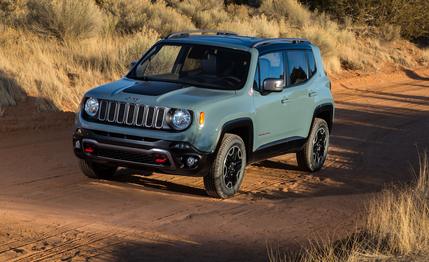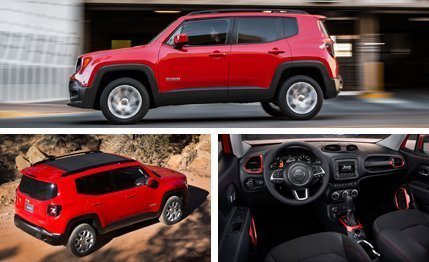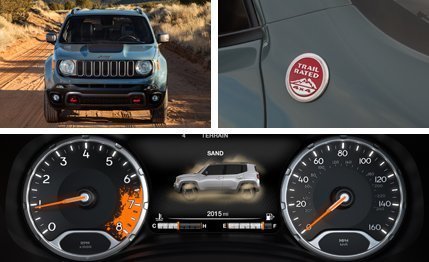 First Drive Review
First Drive Review
Like hair extensions, brand extensions make us wince. We like authenticity. But no matter how deeply ingrained a brand’s identity, that identity still belongs to a company, not a church, and a company’s first priority is not adhering to a belief system, it’s making money. Given that, the allure of selling out is easy to see. (Hint: It’s the “selling” part.)
Whether or not Jeep’s new Fiat-based Renegade is a sellout, it will likely sell. The Wrangler and the Grand Cherokee, Jeep’s purest-blood offspring, each sold around 175,000 units last year. The Patriot and the Compass, Jeep’s Dodge Caliber–based rental-fleet bastards, combined for about 150,000. The Renegade’s big brother Cherokee didn’t even exist two years ago, but it sold as well in 2014 as Jeep’s decades-old core products. Few industry executives would veto any decision that is likely to increase their sales by 25 percent so quickly.
The Renegade certainly doesn’t look like a sellout, although it does look weird. Then again, its segment includes so many outlandish shapes—Kia Soul, Nissan Juke, Mini Countryman—that it’s not so much a class of vehicles as it is a clown college. And it’s about to get weirder with the Chevy Trax, Honda HR-V, Mazda CX-3, and the Renegade’s sibling rival, the shapely Fiat 500X. Odd it may be, but the Renegade doesn’t look bad, and it certainly isn’t as cheap as the Patriot or as dorky as the Compass. It’s cheekily, confidently butch without being overdone, its upright stance, trademark grille, and taillights that protrude from the bodywork immediately identifying it as a relative of the Wrangler.

Inside, the design theme is something Jeep calls “Tek-Tonic.” To us, that sounds like a Silicon Valley fad cocktail, the sort of thing made with lumbersexual-spec craft gin sold in bottles reclaimed from excavated colonial New England outhouse pits. (Don’t worry, it’s alcohol! It kills any lingering bacteria.) But that’s not what Tek-Tonic is. Well, not this one. This one is a blend of soft and rugged forms befitting a tiny, stylish off-roader, and it looks nicer than one might expect in a sub-$20,000 Chrysler product. Anodized-look trim adds a touch of richness, and even the interior door handles and lock tumblers are finished in matte silver.
In keeping with recent Chrysler fashion, there are little design embellishments—Jeep thinks of them as Easter eggs—everywhere, including a topographic map of Moab in the center-console storage bin, Jeep grilles on the speaker grilles, and Willys Jeep silhouettes at the base of the windshield and on the latches for the optional “My Sky” removable roof panels over the front and rear seats. There are whiffs of cheapness, but the palette of main and accent interior colors—black, brown, gray, red, copper—borders on Mini-esque. The low beltline, high roof, and upright greenhouse make for great visibility and a spacious-feeling interior. Very tall drivers will find that the headrests poke them between the shoulder blades, though, and the My Sky roof cuts into headroom.
Jeep says My Sky hearkens to the “open-air freedom that originated with the legendary 1941 Willys MB Jeep,” but seeing as the MB was developed for duty in World War II, we’d replace “open-air freedom” with “naked, unprotected wartime terror.” But that’s not a good marketing angle. Removing the two panels is a bit complicated compared to opening the average power sunroof, requiring two hands—the better to discourage people from opening them while in motion, which would surely result in the panels blowing off of the vehicle. But compared to folding the soft top on a Wrangler, which takes two well-practiced people at least a few minutes, it’s speedy. The Renegade will give you that wind-in-the-hair feeling; you just have to prove you want it.

Surprisingly, that feeling isn’t the only fun thing about the Renegade. Built on FCA’s Small-Wide 4x4 platform—as distinct from the Compact U.S.-Wide architecture that underpins the Cherokee and the Dodge Dart—it feels more like a hot hatch than we expected of a half-scale rock crawler, with startlingly neutral balance, although there’s a good deal of body roll. The steering rack is one of few pieces the small-wide platform shares with the compact-wide one, which is fine, as the rack is one of the Cherokee’s great surprises. Nicely weighted and quick, the Renegade’s steering enjoys a linear buildup and decent feedback that had us wondering which not-for-America Fiats have steering so good. The brakes, too, are better than we expected from a Jeep. They’re progressive and easy to modulate, even though there is a fair bit of dive. We did note a touch of fade, but in the Renegade’s defense, it was while barreling down what felt like a Red Bull extreme soapbox-derby course.
Weight ranges from just over 3000 pounds for a front-drive Sport (base) model to north of 3500 for a loaded-up Trailhawk, which is awfully heavy for this class. (The last Juke we tested was 3170 pounds; the last Soul 3112.) Two powertrains are available for moving all of that bulk. The base is Fiat’s turbocharged 1.4-liter MultiAir four-cylinder. At its peak boost of 22 psi, the 1.4 makes 160 horsepower and 184 lb-ft of torque. It’s mated exclusively to a manual transmission. The gearbox is shared with the Dart, but Jeep’s powertrain engineers did a lot of work to refine shift action and it paid off. This, too, has the precision feel of a hot-hatch piece, and it’s paired with a clutch pedal that is rich in feel and has a nice, gentle takeup. We liked the turbo’s relatively beefy low end, its quiet whistle, and its faint blow-off gulp.
Opt for the 2.4-liter naturally aspirated four-cylinder and you gain 20 horsepower but sacrifice 9 lb-ft of torque. We had a very difficult time discerning a difference in pace with the two engines, although there is a difference in character. The bigger four is gruffer, becoming a little coarse at high rpm. The torque peak also rises from 2500 rpm with the turbo to 3900 rpm. The bigger four is combined only with Fiat Chrysler’s nine-speed automatic, and the plethora of forward ratios means the engine is in its sweet spot no matter your road speed. In the Cherokee, we never actually got the transmission to shift into ninth; on this drive, we never got up to a speed where we bothered trying. With either powertrain, Jeep claims highway fuel economy exceeding 30 mpg; that’s likely only with front-wheel drive, however.